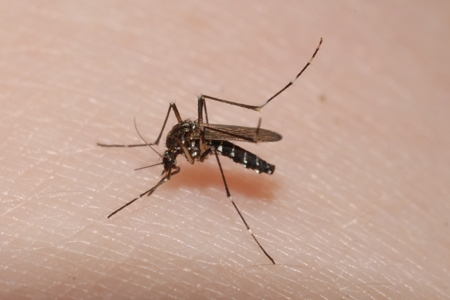Active Seasons




Mosquito Appearance and Size Facts
Mosquitoes in Florida have slender bodies, long legs, and narrow wings. They have a pair of front wings and a pair of reduced hindwings called halteres. They also have plumose antennae and come in various colors, from black to gray, often showing distinct body markings.
These tiny insects are approximately half an inch long and are most active at dawn and dusk, though some species are active in the day. It’s crucial to take mosquito precautions due to their ability to transmit diseases.
Identifying Mosquitoes From Other Flies
You can identify mosquitoes by searching for specific characteristics, like their slender bodies, six legs, hairy two wings, and their proboscis mouthpart. One key feature is that mosquitoes fly in a zigzag pattern, making them easy to locate. They land on surfaces and take off quickly, which can make them hard to kill. In addition, they make a buzzing sound different from other flies, so it’s easy to spot mosquitoes and take preventative measures.
We offer mosquito control in the following locations and their surrounding areas:

Behavior and Habitat of Mosquitos
Historically, mosquitoes have caused problems for humans and animals because they need blood to lay eggs. Males eat carbohydrates, like nectar, but females eat blood with their elongated proboscis. They can transmit dangerous illnesses like malaria, dengue, Zika, and West Nile virus.
Some mosquitoes breed right where they attack people, while others, like container breeders, lay their eggs anywhere there’s water. Warm, humid climates have ponds, marshes, vegetation areas, bushes, water holding plants such a bromeliad, and other standing water where mosquitoes can lay their eggs. Mosquitoes are capable of detecting carbon dioxide and body heat. Hulett has over 50 years of experience with mosquito control in Florida. We know their behavior and preferred habits, which is crucial to controlling them effectively.

Signs of Infestation of Mosquitos
Mosquitoes buzz at dawn and dusk, indicating an infestation. They tend to hover around warm-blooded hosts. Bird baths, lawn equipment, buckets, garbage cans, unmaintained pools, stored boats, clogged gutters, tires, bromeliads, puddles, and water containers are prime targets for infestations caused by stagnant water.
In Florida, mosquitoes remain active most of the year due to the tropical climate, moderate to warm temperatures, heavy rainfall, and high humidity. The mosquito season lasts virtually all year, so Florida homeowners should take precautions against mosquito infestations.

Tips for Prevention of Mosquitos
In addition to turning over unused plant pots and disposing of items that collect water, such as old tires and broken buckets, you can practice several other effective methods to prevent mosquito infestations. Regularly inspecting your surroundings for breeding areas can deter female mosquitoes from feeding on you. Use insect repellent to keep mosquitoes away.
Keep gutters clean, eliminate standing water around your property, and clean containers like flowerpots and bird baths to keep water out. Insect repellents like DEET are helpful if spending time outdoors during dawn or dusk. The best way to reduce mosquito presence and bite risk is to stay inside during peak mosquito hours at dawn and dusk.
Getting Rid of Mosquitoes
If you want a comfortable environment, reduce mosquito activity on your property. Unclog gutters, empty birdbaths, and cover outdoor containers to eliminate stagnant water sources. You can deter mosquitoes by planting herbs like citronella, lavender, and lemon balm in your garden.
Putting screens in your windows and doors can also help keep mosquitoes out. Lastly, if you’re experiencing a severe infestation, Hulett Environmental Services can provide eco-friendly mosquito reduction services. By taking these steps, you’ll be able to eliminate mosquitoes effectively and enjoy time outside.
Effective Mosquito Control Solutions
Hulett Environmental Services is the best place to find effective mosquito control solutions in South Florida. We have reduction programs and mosquito fogging to improve your outdoor spaces. Our commitment to customer satisfaction extends beyond mosquitoes, with highly effective pest and bug management services.
Don’t let mosquitoes ruin your outdoor experience–contact Hulett Environmental Services today to schedule a free inspection and for reliable mosquito control in Wellington, West Palm Beach, or anywhere in South Florida.



